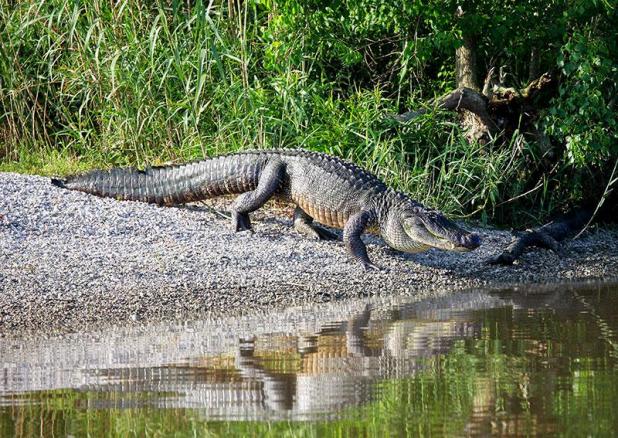
Only the largest of alligators will command better pricing this year, albeit not much at $10 per foot. (Submitted Photo/Courtesy of John K. Flores)
Not much demand for alligator skins this year
One of the things you can pretty much take to the bank following the long Labor Day weekend here in St. Mary Parish is alligator season opening the following Wednesday.
Oh, sure, gator season has been open in the east zone for a week by then. Moreover, the east zone does catch a sliver of St. Mary Parish along the Atchafalaya River, but by and large, the majority is in the west zone.
It’s not that the season is closed this year. On the contrary, it’s still on. Only something is different. And what’s different is many of the large land companies aren’t participating in the wild alligator harvest because of suppressed prices the reptiles are bringing.
Perry fur and alligator hide buyer Wendell Nunez says one of the reasons for lower prices is due to an over-abundance of farm-raised gators.
“Twenty to 25 years ago, you had nearly zero farm gators,” Nunez said. “Back then, 99 percent of the alligators harvested were wild. Today, there could possibly be a million farm gators on the market. And that doesn’t include caiman being raised in South America and crocodiles being raised in South Africa and Australia.
“Based on all of the major land companies who are not going out to catch wild gators this year, I could see a maximum of maybe 7,000 alligators being caught and sold this year,” Nunez said. “It’s going to be a real situation going forward, I tell ya.”
The Louisiana Department of Wildlife and Fisheries annually issues roughly 38,000 tags to landowners. Nunez said when the season started, alligator hunters would be looking at somewhere around $10 per foot for larger gators. Larger gators, according to the buyer, are 8 foot and above.
From $10, prices declined, where Nunez guessed wild alligators would possibly go for $6 per foot for 7-foot-long animals, $5 for 6s, $3 for 5s, and possibly $2 for 4s.
Worse, that’s only if you can find a buyer.
If there is any consolation, it’s that wild alligators, though prices are low today, always will have some demand because farm gators aren’t typically sold at a length not much longer than 4, 5 or 6 feet. It’s too costly for gator farmers to raise them beyond that length.
Farm alligators are grown fast by keeping them in controlled temperatures where they eat year around, unlike wild gators that go dormant following the first cold fronts each fall. Farmers will heat the environment alligators are kept in to increase their metabolism, thus increasing their growth rate.
One of the advantages of farm-raised alligators is typically they are in prime condition when hides are sold. Farm gators don’t have the scars, damage and eaten limbs wild alligators often do.
As of 2017, there are eight southern states with large enough populations of American alligators to hold controlled harvests. What’s more, it’s possible that North Carolina, with a stable and growing population, could become the ninth state as time goes on.
Louisiana and Mississippi, since the ’70s, have been joined at the hip with their respective alligator harvest programs, although their approach to managing this renewable resource differs. Early on, the Louisiana Department of Wildlife and Fisheries worked closely with the Mississippi Department of Wildlife, Fisheries and Parks, transferring 4,000 alligators from Rockefeller Wildlife Management Area in coastal Louisiana to Mississippi.
Where Louisiana manages with its focus primarily on commercial alligator harvest, Mississippi manages recreationally, according to Mississippi Department of Wildlife, Fisheries & Parks Alligator Program Manager Ricky Flynt.
“Our desire was to make our alligator program a recreational sport hunt from the beginning,” Flynt said. “Louisiana has 20-fold more habitat for alligators than Mississippi does. But, our program has grown tremendously. The program started in 2005, and at the time, it was a very small harvest. We issued 50 permits that first year for a 13-mile stretch of public waters along the Pearl River.
“In 2014, 7,400 people submitted applications,” Flynt added. “And in 2015, we went to a first-come, first-serve basis. We issued 920 permits in 45 minutes and had over 11,000 people that year, using some kind of electronic or computer device, trying to get one.”
Besides a flooded market, the fashion world plays a critical role. What may be popular today won’t be tomorrow. The demand for quality reptile leather products isn’t flourishing.
However, one advantage Mississippi’s sport alligator hunters have is they don’t have a commercial interest and aren’t typically looking to sell their hides. Instead, they’re usually hoping to put a little meat in the freezer and draping a tanned trophy skin over the back of their couches.
There have been a few wild alligator purchases made locally at processing sites when the east zone opened last week.
How much of a demand there is remains to be seen. Quite often, prices decline after the first couple days when quotas are reached by buyers. This year, those quotas aren’t going to be much.
